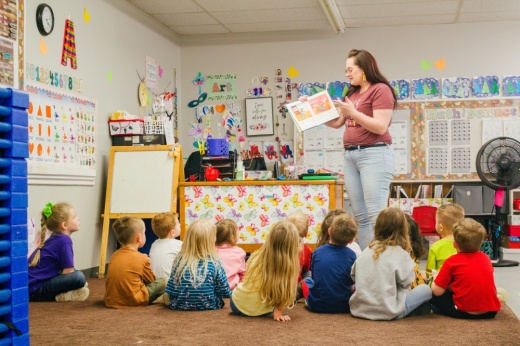Parents across the state—including those in Tomball and Magnolia—have seen increased wait times to secure spots at child care facilities, and officials said the problem could be exacerbated by the halt of relief funding provided early in the pandemic.
According to a July 2023 report issued by nonprofit Children at Risk, a third of all Texas ZIP codes—including three in the Tomball and Magnolia area—qualify as “child care deserts,” meaning there are three times more children eligible for early child care than the number of seats available.
Since 2020, Texas child care providers have received more than $4 billion in federal relief funds. However, the relief funds expired in September.
Some local child care providers operating at prepandemic capacity said wait times to secure a seat could be affected by the loss of funding. However, they said they’re growing to meet demand while remaining financially frugal.
What’s happening
In the Tomball and Magnolia area, three ZIP codes qualify as child care deserts: 77375, 77355 and 77362.
To determine child care deserts, Children at Risk officials used 2022 U.S. Census Bureau data to define a child as eligible for care if they were age 5 or younger and both of their parents were employed.
Kim Kofron, Children at Risk’s senior director of education, said she believes access to child care has been a problem statewide for decades but was further complicated by the pandemic.
Kofron said Texas had around 17,000 early child care centers before the pandemic hit in 2020. While that number had fallen to roughly 12,000 in 2021, she said the number of providers has rebounded to around 14,000.
Despite the increase, Kofron said more than 70,000 kids throughout the state are currently on waitlists to receive early child care.
Hockley resident Kadie Sellers said she applied to a handful of child care centers around Tomball and Cypress two months before her child was born in January 2023.
“I waited until I was in the third trimester of my pregnancy, which I thought was a reasonable amount of time because I was going to be on maternity leave for a few months,” she said. “We finally got a call for a spot in October. [My child] was 9 months old.”
Matt Evers—co-owner of several Primrose Schools, including a location in Tomball—said he believes parents should apply at least six months in advance of the date they want their children to attend. He said that wait can increase to as much as two years for infants.What they’re saying
- “The one thing about child care is that it costs a lot of money to operate the centers. We hope that laws will be passed and things will happen to where there will be funding to help us. In our hearts, we want to take care of the children, but we have to have those funds to be able to expand.” —Annette Collins, executive director, God’s Grace Learning Center
- “We took a hit [in enrollment] during COVID, as so many facilities in the industry did, and it was a challenge climbing back up to those pre-COVID numbers, but we are getting there. As we grow, we are able to open other classrooms and meet the demand.” —Leylea Dumstorss, director, A Child’s View
- “It’s hard to make child care profitable anywhere you are, but it’s even harder to do that in a low-income area. We do find low-income areas to be more likely to have higher child care deserts than our middle-income and more affluent neighborhoods.” —Kim Kofron, senior director of education, Children at Risk
Zooming in
Kofron said the industry could take a hit with the loss of federal relief funds. According to the nonprofit’s report, the relief funds helped support more than 80% of child care centers in Texas.
“Really, what that extra money provided was a bedrock of funding that allowed centers to pay their staff more—to be able to keep tuition lower for families,” Kofron said. “That money is gone now.”
Annette Collins, executive director of God’s Grace Learning Center in Tomball, said she used relief funds to raise wages and provide other perks.
“Any hourly job is hard to retain staff, so those funds put us in a position where we can pay our staff better,” she said. “That attracts a different type of clientele and staff as well.”
Leylea Dumstorss, director of A Child’s View in Magnolia, said operation of the day care has not changed with the loss of federal funds, aside from finding it harder to hire quality staff.
“We are paying a little bit better than what the average facilities are, but we are finding as we expand and grow it is becoming a challenge to hire staff,” she said. “We have the kids; we are just needing the teachers.”
Kofron said the funding loss coupled with inflation could lead child care providers to raise tuition rates that are already too high for many families.
According to a 2023 analysis by nonprofit Council for a Strong America, the nation’s child care crisis costs $122 billion in lost earnings, productivity and revenue from parents, businesses and taxpayers every year.
- $5,520 lost by families per working parent in reduced earnings due to insufficient child care access and time spent looking for work if they’re fired as a result, totaling roughly $78 billion annually
- $1,640 lost by businesses per working parent in reduced revenue and in extra hiring costs, totaling roughly $23 billion annually
- $1,470 lost in tax revenue per working parent due to decreased income tax revenue and decreased sales tax revenue from reduced spending, totaling roughly $21 billion annually
What’s next
While Kofron said she was disappointed the state Legislature failed to approve an additional $2.29 billion for early child care that was originally included in the state’s budget, she pointed to a handful of bills that were approved aimed at assisting child care providers in Texas.
- Senate Bill 1145 allows local tax authorities to give property tax relief to some child care programs
- House Bill 2729 lowers hiring qualifications for pre-K teachers at child care centers partnering with local school districts
- House Bill 1615 helps child care centers become eligible to partner with local school districts to provide care for pre-K aged students






